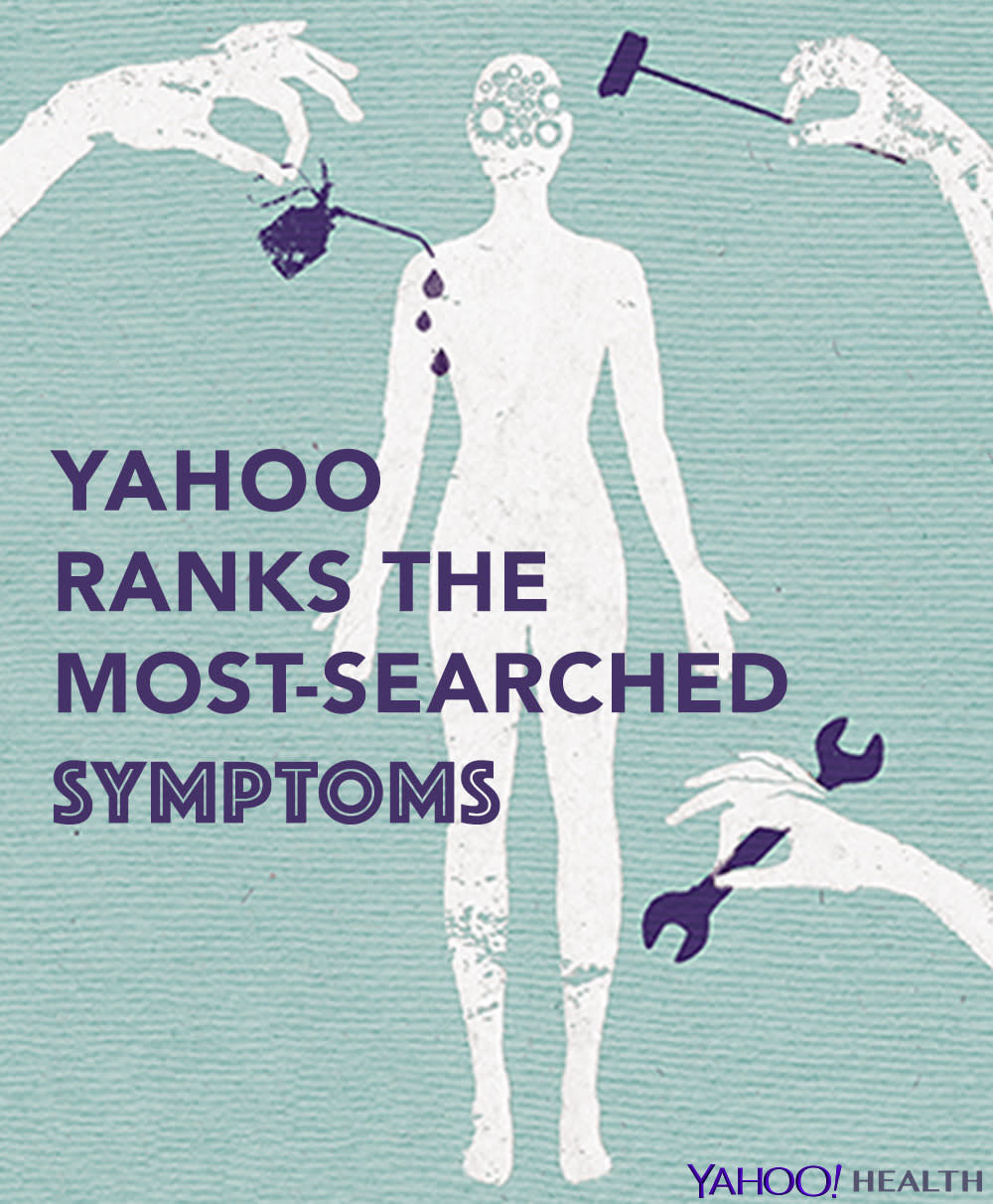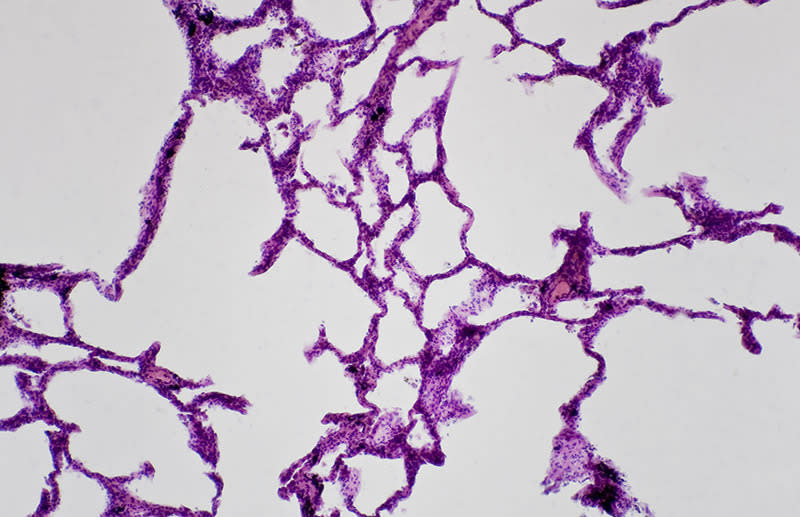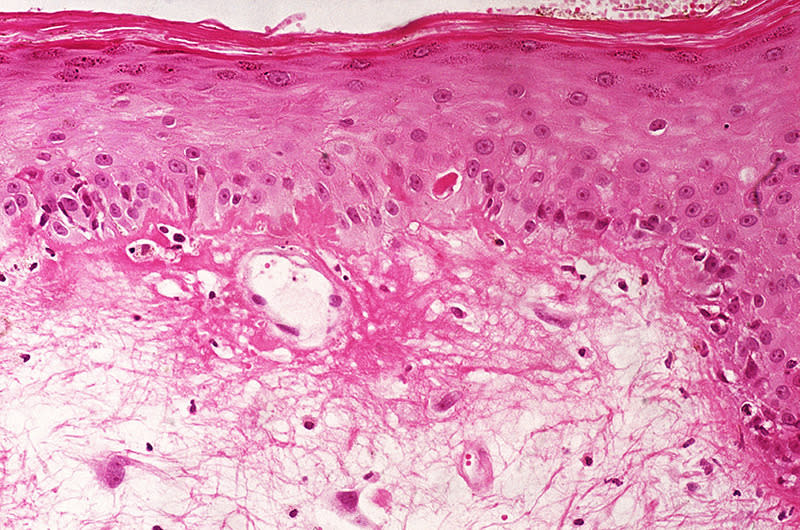10 Health Problems You Think You Have

What symptoms are you worried about? (Photo: Yahoo Health/Getty)
Something’s off with your body— but you’re not sure quite what. Your likely first stop: The Internet.
We at Yahoo Health would encourage you to see your doctor if you suspect something is amiss with your health— after all, research shows that online symptom checkers are often wrong.
But despite some doctors warning against doing so, the fact of the matter is that we do tend to head to search engines at the first sign of a malady. We rounded up the top searched symptoms on Yahoo to find out the conditions we’re most curious about.
1. Diabetes

(Photo: Stocksy)
Around one in 11 people in the U.S. has diabetes (21 million people), with more than a quarter of people with the condition being undiagnosed (8.1 million, according to 2014 data from the Centers for Disease Control and Prevention. Type 1 diabetes — which makes up 5 percent of diagnosed diabetes cases — occurs when the body doesn’t make enough insulin, and while it can develop at any age, it usually is diagnosed in childhood or adolescence. Type 2 diabetes, on the other hand, is often preventable and occurs when the body cannot properly use insulin. This kind of diabetes is far more common, with at least one out of three people developing it at some point in their lives.
Symptoms of both types of diabetes can vary depending on the person and his or her blood sugar levels, but often include presence of ketones in the urine, hunger, frequently needing to pee, feeling thirsty, blurred vision, sores that take a long time to heal, frequent infections, and fatigue, according to the Mayo Clinic. People with Type 1 diabetes may also experience unexplained weight loss, while people with Type 2 diabetes may also experience tingling, numbness, or pain in the hands or feet, the American Diabetes Association says.
2. Depression

(Photo: Stocksy)
Depression is a mental health disorder, with nearly 7 percent of adults in the U.S. (15.7 million) experiencing a major depressive episode (depression lasting two weeks or longer) at least once in the past year.
There are multiple kinds of depression (you can find more about them here), and symptoms may vary depending on the type. But in general, symptoms include persistent feelings of sadness or hopelessness, feelings of guilt, loss of interest in activities you used to find pleasurable, fatigue, sleep problems (insomnia or sleeping too much), overeating, and thoughts of suicide. If you experience any of these symptoms and suspect you have depression, it’s vital to seek treatment from a health professional.
Related: The 10 Different Kinds of Depression Prove the Condition Is Not One-Size-Fits-All
3. COPD

(Photo: Getty Images)
Chronic obstructive pulmonary disease (or COPD) is a disease that makes it hard to breathe, and affects more than 24 million people in the U.S., according to the COPD Foundation. It includes two main conditions (most people have both at the same time): chronic bronchitis — which is when airway lining is irritated and inflamed, causing the lining to become thickened and mucus to form — and emphysema — which is when the walls of the air sacs within the lungs are damaged, according to the National Institutes of Health. COPD is the third leading cause of death for Americans, and is most often caused by cigarette smoking.
Symptoms get worse over time, and usually only appear once lung damage is already significant, the Mayo Clinic says. Symptoms include wheezing, shortness of breath, excess mucus (leading to having to clear your throat when you first wake up in the morning), chronic coughing, frequent respiratory infections, and, in later stages, unintended weight loss.
4. Rheumatoid Arthritis

(Photo: Getty Images)
Rheumatoid arthritis is an autoimmune disorder that affects about 1.5 million U.S. adults, according to CDC data. It affects the lining of the joints and causes swelling, which can lead to joint deformity and erosion of the bone, the Mayo Clinic says. (This is different from other kinds of arthritis, such as osteoarthritis which is caused more from wear-and-tear.)
Rheumatoid arthritis can affect any joint, but most often affects the wrist and small joints within the hand, such as the knuckles and middle finger joints, as well as joints in the feet, according to the American College of Rheumatology. While pain, stiffness, and swelling are the hallmark symptoms of RA, other symptoms can include dry eyes/mouth, appetite loss, fever, loss of energy, and rheumatoid nodules (lumps beneath the skin).
5. Lupus

(Photo: Getty Images)
Around 1.5 million people in the U.S. have lupus, most of whom are women, according to the Lupus Foundation of America. Lupus is considered a chronic inflammatory disease, and occurs when the body’s immune system attacks its own healthy tissue and cells (thereby affecting different parts of the body, such as the heart, lungs, skin, joints, and kidneys). There are different kinds of lupus, the most common of which is systemic lupus erythematosus (where multiple parts of the body are affected), according to the National Institute of Arthritis and Musculoskeletal and Skin Diseases.
The tell-tale sign of lupus is a butterfly-like rash on the cheeks of the face, but this does not occur in 100 percent of cases, the Mayo Clinic notes. Symptoms can often mimic those of other conditions, making the condition hard to diagnose. Other symptoms include mouth or nose ulcers, chest pain, sun sensitivity, joint pain and swelling, fever, headaches, and extreme fatigue, according to the Lupus Foundation of America.
6. Thyroid

(Photo: Getty Images)
Women are more likely than men to experience these thyroid diseases, with one in eight women having a thyroid problem at some point in her life. Problems with the thyroid (which is the gland at the base of your neck that produces thyroid hormone) can include:
Hypothyroidism, which is when not enough thyroid hormone is being produced, causing symptoms of fatigue and weight gain, among others.
Hyperthyroidism, which is when too much thyroid hormone is produced, causing symptoms of sudden weight loss, menstrual changes, tremors, goiter, and sleep problems.
Thyroiditis, which is inflammation of the thyroid, and can produce different symptoms depending on the type of thyroiditis.
Goiter, which is when the thyroid is unusually enlarged, causing neck swelling and sometimes even coughing and problems with swallowing or breathing.
Thyroid nodules, which is when one section of the thyroid gland becomes swollen. Depending on how big the nodule is, it can be felt or appear as swelling at the base of the neck.
Thyroid cancer, which can appear as a lump or swelling in the neck, pain at the front of the neck, problems with swallowing or breathing, a cough that won’t go away, and voice changes that won’t go away.
7. Acid Reflux

(Photo: Getty Images)
Acid reflux, or gastroesophageal reflux or heartburn, occurs when stomach acid comes and flows back up into the esophagus, causing irritation to the esophageal lining. While most people will experience gastroesophageal reflux occasionally in their lifetime, people who experience this condition more than twice a week for a few weeks might have gastroesophageal reflux disease (GERD), according to the National Institute of Diabetes and Digestive and Kidney Diseases. About one in five Americans has GERD.
Symptoms include feeling a burning sensation in the chest and sometimes even the throat, dry cough or sore throat, regurgitation of food or sour liquid, and problems swallowing, according to the Mayo Clinic.
8. Asthma

(Photo: Getty Images)
Asthma is a chronic condition where the airways of the lungs become inflamed and narrowed, making it hard to breathe. Around one in 12 people in the U.S. has asthma (or around 25 million people), and rates only seem to be increasing, according to the Centers for Disease Control and Prevention.
Symptoms most commonly include wheezing, coughing (especially when laughing or during exercise), shortness of breath, and feelings of tightness in the chest, according to the American College of Allergy, Asthma & Immunology.
9. Bipolar Disorder

(Photo: Stocksy)
Bipolar disorder is a mental health condition that affects about 2.6 percent of U.S. adults, according to National Institute of Mental Health statistics. Most of these cases are considered “severe.” People with bipolar may experience manic episodes, where mood and energy levels are high for at least a week; hypomanic episodes, where mood is higher than normal or a person is more irritable than normal for at least four days in a row; and depressive episodes. These are not the same typical ups and downs in mood and energy that a person without the condition experiences.
There are different types of bipolar disorder, including bipolar I and bipolar II. Bipolar I is diagnosed when you’ve had at least one manic episode, that comes before or after a depressive episode or a hypomanic episode. Bipolar II is diagnosed when you’ve never had a manic episode, but you have had at least one depressive episode that lasts at least two weeks, as well as at least one hypomanic episode lasting a minimum of four days, according to the Mayo Clinic.
Related: What People Get Wrong About Bipolar Disorder
10. Low Testosterone

(Photo: Stocksy)
Low testosterone, or hypogonadism, is a condition where a man’s testosterone levels decrease; this phenomenon happens with age. Testosterone is a sex hormone that plays a role in men’s mood, muscle mass, bone density, and sex drive, according to the American Urological Association. Recent data show that around one in four men older than 30 experiences lower testosterone levels, but that one in 20 men experience low-T to the level where it’s considered an actual deficiency.
Symptoms of low testosterone include weaker and fewer erections, having a low sex drive, depression, low energy, bone calcium loss, anemia, and body fat increase, the American Urological Association reports.
Read This Next: 5 Signs You Should Have Your Testosterone Levels Checked

